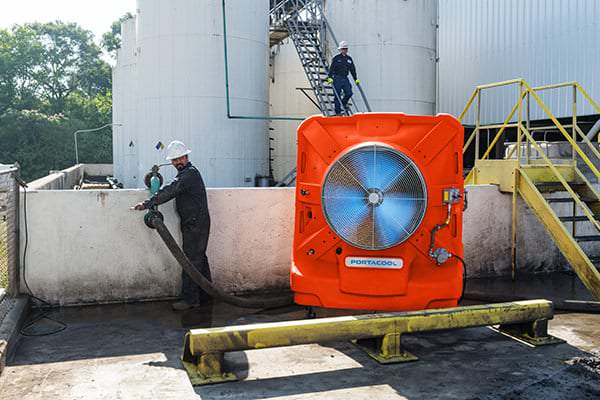Not all work environments are ‘created equal’
“Under OSHA law, employers are responsible for providing workplaces free of known safety hazards,” OSHA’s “Water. Rest. Shade.” heat illness prevention  campaign page states. “This includes protecting workers from extreme heat.”
campaign page states. “This includes protecting workers from extreme heat.”
Here, Misty Wilburn, marketing manager at Portacool, and Alsie Nelson, senior product manager at Ergodyne, weigh in on how employers can do that.
Safety+Health: Have there been recent innovations in heat protection?
Misty Wilburn: Innovations in the heat protection field have come through the use of nontraditional cooling, such as portable evaporative cooling, in nontraditional places. Several occupations, including oil field workers, manufacturers and automotive mechanics, have long thought heat was just an occupational hazard because of the challenging work environment. Due to the technology behind today’s evaporative media and cooling, even the most hard-to-cool spaces can get relief, keeping employees safe, comfortable and ultimately productive.
S+H: What do you wish employers and workers better understood about heat protection?
Wilburn: When it comes to cooling, there are options. Environments are not all created equal, and therefore they do not all have a one-size-fits-all solution. Depending on the dimensions and specifications of your environment, you may need a few large portable evaporative coolers that cool and move air around a large space. Or, if you have heat-generating machinery, you may be better off with a smaller product to spot-cool the person that is closest to the heat. No matter the cooling need, it is important to customize your solution to you.
Alsie Nelson: A closely related topic I wish the workforce better understood – in addition to mitigating heat-related illness – is the importance of skin protection. Heat stress prevention programs should really include considerations for preventing sun damage, too – including sunscreen, UPF clothing, hats/brims/neck shades, UV-blocking eyewear, and portable shade. The likelihood of developing skin cancer for those who work outdoors is 3.5 times higher than for those who do not. And the sun damage risk on worksites is so high OSHA has identified UV as a carcinogen. With skin cancer expenses exponentially increasing (more than $8 billion spent annually), treatment costs are detrimental to both workers and their employers.
S+H: What concerns or questions are customers coming to you about heat protection?
Wilburn: A lot of customers come to us concerned about how to keep their employees cool if they can’t afford A/C, or if traditional A/C is impractical in their environment. We urge people to look outside of traditional cooling for affordable, efficient methods. Evaporative cooling can provide relief to buildings that may not have insulation, have heat-generating machinery, or have to keep bays or docks open during operation. Portable products can even work outside as spot cooling stations for contractors. Customers needn’t be afraid to try something unconventional because the payout – both in employee productivity and cost efficiency – will prove worth it.
S+H: What is on the horizon for heat protection?
Wilburn: The process of evaporative cooling is not a new concept, but the science, materials and innovation that go into the design and products is continually bringing it to the forefront of cooling options. Heat safety and protection will always be important and, as evaporative cooling technology continues to evolve, historically underserved industries are going to get the relief they deserve.